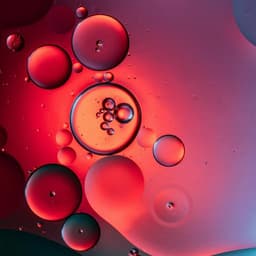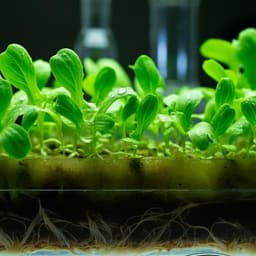
Chemistry
Critical impacts of interfacial water on C-H activation in photocatalytic methane conversion
H. Sato, A. Ishikawa, et al.
This groundbreaking research by Hiromasa Sato, Atsushi Ishikawa, Hikaru Saito, Taisuke Higashi, Kotaro Takeyasu, and Toshiki Sugimoto reveals how interfacial water species can enhance photocatalytic methane conversion, achieving over 30 times improvement in conversion rates under wet conditions. Discover the role of these unique water interactions in advancing non-thermal catalytic processes.
~3 min • Beginner • English
Introduction
Methane has exceptionally strong C–H bonds (bond dissociation energy ~439 kJ/mol), making its activation under mild conditions challenging. Industrial conversion typically relies on energy-intensive steam reforming at high temperatures and pressures. Photocatalysis can drive redox reactions at ambient conditions, but the microscopic mechanism of non-thermal methane activation remains unclear. Prior studies indicate photogenerated holes can exist as trapped holes at lattice oxygen sites or as surface hydroxyl/ad-atom oxygen radicals derived from adsorbed water, yet traditional ex-situ methods obscure the true working-state chemistry. The research question addressed here is which hole-derived reactive species initiate C–H activation of methane under photocatalytic, ambient conditions and how interfacial water influences this process. The study aims to elucidate the mechanism using operando measurements and simulations to enable rational design of efficient methane photocatalysis at ambient temperature and pressure.
Literature Review
Previous work has demonstrated photocatalytic reactions such as water splitting and CO2 reduction under ambient conditions and reported attempts at photocatalytic methane conversion. Spectroscopic studies have identified various surface hole states (e.g., holes trapped at surface lattice oxygen and radical species originating from adsorbed water). However, these identifications often rely on ex-situ or cryogenic conditions, spin traps, or marker molecules, which can perturb the intrinsic reaction environment. For water splitting, the role of lattice oxygen depends on catalyst type (e.g., d10 vs d0 oxides), but such material-dependent behavior in methane conversion had not been clearly resolved. There is also a thermodynamic perspective suggesting methane oxidation is more favorable than water oxidation (E°CH3/CH4 = 2.06 V vs SHE at pH 7 vs E°OH/H2O = 2.73 V), but kinetic factors and interfacial environments may dominate in working systems. The need for in-situ/operando, non-invasive techniques is emphasized to clarify the active species and intermediates in methane photocatalysis.
Methodology
Experimental: Three oxide photocatalysts were studied: Pt/Ga2O3 (d10), Pt/NaTaO3 (d0, La3+-doped 1 mol%), and Pt/TiO2 (d0, anatase). Pt loadings: 1 wt% on Ga2O3 and TiO2; 0.2 wt% on NaTaO3. Photocatalysts were prepared by impregnation (Ga2O3, NaTaO3) and photodeposition (TiO2) followed by drying and calcination (where applicable). A stainless-steel batch reactor (SUS304) with a CaF2 window was used. UV irradiation was supplied by a Xe lamp (approx. 90 mW cm−2 at 250 nm). Reaction atmospheres contained methane (5–120 kPa) and water vapor (0 or 2 kPa; H2 16O, H2 18O, or D2O), with base pressure <1×10−3 Pa before dosing. Under irradiation, the sample temperature increased from ~295 K to ~318 K. Product gases were monitored by quadrupole mass spectrometry (Pfeiffer PrismaPlus QMG220), and reaction rates were obtained from linear fits of product yields vs time, indicating near-steady-state behavior. Isotopic labeling with H2 18O assessed the origin of oxygen in CO2, and D2O labeling enabled operando IR detection of HDO formation. Operando diffuse reflectance infrared Fourier transform spectroscopy (DRIFTS, JASCO FT/IR-6600GP01, HgCdTe detector, 4 cm−1 resolution) monitored surface species under reaction conditions; backgrounds were taken at stable temperature (~318 K). Measurements tracked O–H stretching growth (3000–3600 cm−1) attributable to hydrogen-bonded adsorbed HDO.
Computational: Ab initio molecular dynamics (AIMD) and DFT calculations (CP2K v6.1) modeled a β-Ga2O3 surface with a single-layer water solvation (~34 H2O molecules) in a periodic slab (3×2 surface supercell; ~20 Å vacuum; 222 atoms). Preliminary MD equilibrations used GGA-PBE; production runs used hybrid PBE0 to accurately describe localized holes. MOLOPT basis, GTH pseudopotentials, DZVP basis, plane-wave cutoff 400 eV, electronic convergence 1×10−5 eV. NVT ensemble with Nosé–Hoover thermostat at 300±30 K; equilibration (GGA 10 ps; hybrid 3 ps) followed by 7 ps production per reaction coordinate window. Potential energy curves (PECs) were computed using constrained reaction coordinates: for •OH formation, difference in distances between Ga–O(H2O) and H(H2O)–O_Ga; for methane activation, distance between the O of •OH and H of CH4 (wet) or between H(CH4) and O_Ga (dry). Barriers and reaction energies were derived from averaged potential energies along the coordinate.
Kinetic modeling: Assuming water-assisted initial C–H cleavage yields a surface methyl radical intermediate •CH3 (X1), steady-state rates for products were modeled as R ∝ θ_CH3^n, with n = 2 for C2H6 (surface homocoupling) and n = 1 for CO/CO2 (via multistep oxidation). θ_CH3 follows a Langmuir-type form θ_CH3 = K P_CH4 / (1 + K P_CH4), where K = exp(U/kBT) and U is the stabilization energy of •CH3 relative to gas-phase CH4 under wet conditions. Formation rate vs P_CH4 data were fitted to [K P_CH4 / (1 + K P_CH4)]^n to extract U.
Key Findings
- Interfacial water is essential for efficient photocatalytic methane conversion at ambient conditions. Under dry conditions (no H2O), Pt/Ga2O3 produced only small amounts of ethane and H2 via non-oxidative coupling with very low CH4 conversion (~0.2 µmol/h). Under wet conditions (PH2O = 2 kPa), total CH4 conversion to carbon-containing products (CO2, CO, C2H6) increased to 11.6±0.3 µmol/h at PCH4 = 70 kPa (>30× enhancement), with a concomitant increase in H2 formation; similar enhancements were observed for Pt/NaTaO3 and Pt/TiO2.
- Isotopic labeling with H2 18O showed that oxygen in CO2 originates predominantly from interfacial water rather than lattice oxygen: for Pt/Ga2O3, CO2 isotopologues were ~78% C18O2, ~15% C16O18O, ~7% C16O2; analogous water-dominant contributions were observed for Pt/NaTaO3 and Pt/TiO2. Thus, water-derived species, not lattice O_ lat holes, primarily drive oxidative CH4 conversion.
- Operando IR with D2O revealed linear growth of an O–H stretching band (3000–3600 cm−1) assigned to hydrogen-bonded HDO during UV irradiation, with no change in the dark. This evidences hydrogen abstraction from CH4 by surface OD (•OD) to form surface •CH3 and HDO: CH4(g) + OD(ad) → CH3(ad) + HDO(ad). The HDO peak growth rate vs PCH4 correlates with total methane conversion rate, saturating near 1 atm, indicating water-mediated hydrogen abstraction as the initial key step.
- Kinetic isotope effects for D2O vs H2O on methane conversion and total H2 production were negligible, indicating that water activation (formation of •OH/•OD) is not rate-determining in methane photocatalysis, unlike in pure water splitting.
- AIMD/DFT on β-Ga2O3 showed: (i) under wet conditions, water activation to surface •OH has a low barrier (21.2 kJ/mol) and is moderately exothermic (ΔE = −14.9 kJ/mol), so surface holes exist as •OH; (ii) methane C–H activation via •OH hydrogen abstraction has a barrier of 38.4 kJ/mol, feasible at ambient temperature, yielding •CH3 stabilized by hydration with ΔE = −50.2 kJ/mol; (iii) under dry conditions, direct hole-mediated activation produces •CH3 with large exothermicity (ΔE = −90.6 kJ/mol) and very strong adsorption (Eads = −171.9 kJ/mol), causing overstabilization that suppresses homocoupling and favors overoxidation/coking.
- Rate vs PCH4 profiles for C2H6, CO, and CO2 match Langmuir-type behavior with saturation near ~1 atm. Ethane formation rates follow [K PCH4/(1+K PCH4)]^2, indicating surface homocoupling of adsorbed •CH3. CO and CO2 formation rates follow first-order [K PCH4/(1+K PCH4)]. Fitted stabilization energies U (kJ/mol): for C2H6 formation: Pt/Ga2O3 35.9, Pt/NaTaO3 32.7, Pt/TiO2 33.9; for CO/CO2 formation: Pt/Ga2O3 40.1, Pt/NaTaO3 37.2, Pt/TiO2 33.4. These U values align with AIMD-derived •CH3 stabilization (~50 kJ/mol) and exceed typical methane physisorption energies (~15 kJ/mol), rationalizing observable activity at ~1 atm.
- Mechanistically, surface holes preferentially oxidize interfacial water (kinetically favored, lower barrier and higher surface population) to form •OH, which then abstracts H from CH4. The interfacial hydrogen-bond network moderates the stabilization of reactive intermediates, preventing overbinding and deactivation, thereby enhancing activity and enabling operation at ambient conditions. Water assistance also boosts ethane formation despite water not appearing in the coupling stoichiometry.
Discussion
The findings demonstrate that methane activation in photocatalysis proceeds primarily via water-mediated hydrogen abstraction rather than direct oxidation by lattice-trapped holes. Although methane oxidation is thermodynamically more favorable than water oxidation, the kinetics at oxide–water interfaces favor water oxidation: surface holes rapidly generate •OH with a lower barrier, and the interfacial water layer presents higher local concentration and better coupling to hole centers than gaseous CH4. The resulting •OH efficiently abstracts H from CH4, generating a surface •CH3 intermediate moderately stabilized by the hydrogen-bonded network. This proper stabilization (~30–50 kJ/mol) achieves two crucial outcomes: (1) sufficient surface coverage of reactive intermediates at near-ambient pressures (Langmuir-like saturation near ~1 atm), maximizing rates, and (2) avoidance of excessive binding that would impede further reactions or cause coke formation, a risk observed under dry conditions. The consistent behavior across d0 (NaTaO3, TiO2) and d10 (Ga2O3) oxides suggests universality among metal oxide photocatalysts whose valence bands are O 2p-derived and surfaces preferentially interact with water over methane. The mechanistic model explains the non-linear PCH4 dependences and reaction orders (n = 2 for surface homocoupling to C2H6; n = 1 for CO/CO2 via multistep oxidation), providing a predictive framework for optimizing reaction conditions. Overall, interfacial water plays kinetic and microenvironmental roles that supersede simple redox potential considerations, enabling efficient non-thermal C–H activation at ambient conditions.
Conclusion
This study establishes that interfacial water critically enables photocatalytic methane activation at ambient temperature and pressure. Operando IR and isotopic labeling identify water-derived •OH as the species initiating C–H cleavage via hydrogen abstraction, while AIMD/DFT quantifies low barriers for water activation (21.2 kJ/mol) and manageable barriers for methane activation (38.4 kJ/mol) with moderate •CH3 stabilization (≈−50 kJ/mol). Experimentally, wet conditions enhance methane conversion rates by over 30× compared to dry conditions, with oxygen in CO2 predominantly from water. Pressure-dependent kinetics align with Langmuir-type coverage models, confirming surface reactions of •CH3 (n=2 for C2H6; n=1 for CO/CO2) and yielding stabilization energies of ~33–40 kJ/mol. These insights overturn the assumption that methane must be directly oxidized by holes and provide a mechanistic basis for interface engineering—promoting water adsorption/activation and tailoring hydrogen-bond networks to tune intermediate stabilization. Future work should extend to broader catalyst families, explore co-catalyst and surface modification strategies to optimize •CH3 stabilization and selectivity, and develop continuous-flow systems and in-situ probes to further resolve intermediate speciation and durability under realistic conditions.
Limitations
- Catalyst scope is limited to three oxide photocatalysts (Pt/Ga2O3, Pt/NaTaO3, Pt/TiO2); generality to other materials is inferred but not experimentally validated across a wider set.
- Reaction studies were conducted in a batch reactor and at relatively low overall conversion rates (µmol/h scale); scale-up, long-term stability, and deactivation behavior under continuous operation were not fully addressed.
- Operando IR provides indirect evidence of intermediates; comprehensive identification/quantification of all surface intermediates in the multistep oxidation network remains incomplete.
- Computational modeling focused on β-Ga2O3 with a single water layer; other surfaces, defect states, co-catalyst effects, and thicker water films were not explored. AIMD timescales (ps) and system size limit access to rare events and long-time dynamics.
- Pressure and temperature windows are near ambient (PCH4 up to ~1.2 atm; ~318 K); behavior at elevated pressures, varying humidity, and different photon fluxes was not systematically mapped.
Related Publications
Explore these studies to deepen your understanding of the subject.







